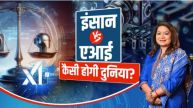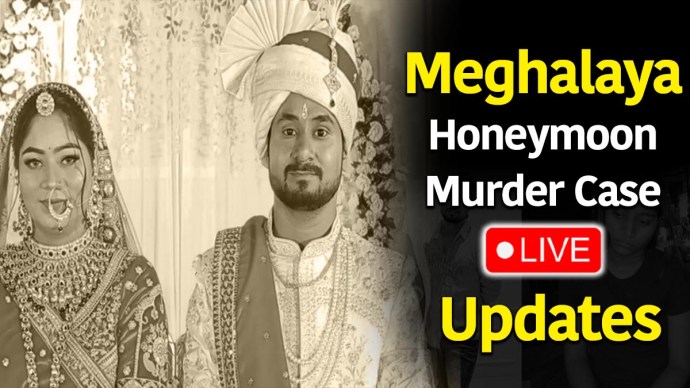Bharat Ek Soch: Sometimes, action speaks louder than words. In a country where the Supreme Judicial Authority – the Supreme Court of India is often seen as a last beacon of hope, an image of a man with folded hands shook the internet. The man closed his eyes, took off his slippers, and stood at a distance outside the apex court as if he were praying. His image felt like he was a devotee worshiping the deity, reflecting on a moment of faith. The event that unfolded that day was actually because a case related to the man was scheduled to be heard in court.
This was more than just a scene – probably a reflection of the immense faith that the common man holds in the judiciary and the judges. Notably, the issue of corruption is being raised in front of the judiciary from time to time. Justice Yashwant Varma recently came under scrutiny after burnt sacks of unaccounted cash were found in his Delhi home, leading to many questions.
Vice President Jagdeep Dhankar even expressed dismay over the lack of action and criminal investigation taken in the matter. According to Chief Justice of India BR Gavai, the judiciary should not just provide justice to the innocents, but also should set an example that the Court stands firm with the truth. Currently, there is an ongoing discussion regarding the judiciary, judges, and their role in the country. The issues that are likely to be discussed during the upcoming monsoon session from July 21 are corruption and impeachment against Justice Yashwant Varma.
This year, Holi was celebrated on March 14. When the whole country was immersed in water colors, a massive fire broke out in a bungalow in Delhi’s Lutyens Zone around 11.30 pm. The residence, located on 30 Tughlaq Road, belonged to Justice Yashwant Varma. However, the catch was that the firefighters who came to douse the flames saw burnt bundles of notes kept in sacks. Questions were raised – Where did the money come from? After the controversy escalated, Justice Varma was transferred to the Allahabad High Court.
The nation wants to know how the Police would treat a common man, a government clerk, or a leader, if bundles of cash were found at their house. Will they treat them equally? Why is an FIR not registered against judges? Shouldn’t there be such a system in the judiciary, when a judge morally distances himself from his own if serious allegations are leveraged against him or he resigns from his post? Have you ever wondered why there is a need to bring an impeachment to remove a judge? What has been the result of the impeachment motions implied against our country’s judges so far? Why is the collegium system behind the appointment of judges also under fire? How will the country’s justice system ensure transparency amidst allegations of corruption and nepotism?
If you get into an argument with someone or if injustice is being done to you, you have the option to knock on the door of the court. Even if an officer is not righteously doing his duty, the court’s door is open. People even approach the court against MLAs, MPs, and ministers. But, which door should you knock on if your case is pending with the court for years? Where will you raise your voice against the corruption present within the judiciary?
Recently, while talking to the members of the Punjab-Haryana High Court Bar Association, Vice President Jagdeep Dhankhar said that over three months have passed and the investigation hasn’t started yet. He criticised the internal judiciary for delaying the FIR. Here, the VC was referring to the Justice Yashwant Varma case. Perhaps he was trying to convey how helpless the government is in front of the judiciary.
Why Was No Preliminary Action Taken In Varma’s Cash Scandal?
The Vice President is pointing out why no preliminary action was taken after the cash scandal came to light. Why was no investigation started even after the Supreme Court’s internal investigation report came? Such a debatable issue makes us wonder – Was this ever within our judicial system, or are the politicians exaggerating the case unnecessarily? Why is the process of removing the judges of the Supreme Court and High Court difficult? What could have been the thinking of the Constitution makers behind the process?
The impeachment procedure against a Supreme Court judge is mentioned in Article 124(4) of the Constitution. At the same time, Article 218 states that these provisions also apply to High Court judges. To ensure that the power and independence of the judiciary are maintained, the impeachment procedure level has been kept very high. The judges can deliver verdicts according to the spirit of the Constitution without any pressure or influence. But remember, no system is 100 percent perfect.
Some people don’t think twice before taking advantage of the shortcomings. Why is a case not registered against a Supreme Court or High Court judge immediately after a serious allegation is made? In the upcoming monsoon session of Parliament, efforts are being made to bring an impeachment motion to remove Justice Yashwant Varma from his post. However, the big question here is whether the government will be able to remove him by impeachment.
What Arguments Did The Legal Experts Give?
The legal experts argue that there cannot be the same process for the common man and the judge. This is because the judge is the one who is authorised to deliver a verdict against the powerful people of society. In such a situation, the question arises – Why did the judiciary not create such a strong mechanism within itself, so that after serious allegations, the judges can be removed or action can be taken? Notably, in America and Britain, the impeachment process, adopted to remove the judges of the Supreme Court, is very difficult. Meanwhile, in the Indian tradition, justice is the country’s moral backbone. When the king is unable to deliver justice, he starts appointing judges as his representatives. Such persons are chosen as judges, on whom the trust of people builds and remains.
At present, the appointment of judges of the Supreme Court and High Court in our country is done through the collegium system. Article 124 (2) of the Constitution is related to the appointment of judges of the Supreme Court and Article 217 of the High Court. This tradition remains a part of our system and plays a major role in the appointment and transfer of Supreme Court and High Court judges. It can also be seen as a bridge between the judiciary and the government in the appointment of judges.
From Appointment To Transfer Under The Collegium system
Chief Justice of India BR Gavai admits the flaws in the collegium system of appointment in the judiciary. However, on the other hand, he talks about keeping the judges free from external pressure. It is often argued that there is no solid mechanism in the collegium system; it has become a closed-door system. If the collegium approves some names and forwards the recommendation for appointment to the government, the Centre doesn’t need to give a green signal every time. Notably, the appointment of High Court judges is also done through the collegium system. The same system works in the transfer of High Court judges as well. In such a situation, the blame for the delay in the appointment of judges is sometimes put on the collegium and sometimes on the government.
To correct the shortcomings that come in the appointment process of judges amid the lack of transparency in the collegium and allegations of nepotism, the Modi government brought a new law in 2014 through constitutional amendment, named ‘National Judicial Appointment Commission Act.’ Under this law, a 6-member commission was to be formed for the appointment of judges. When this law came into force, it was challenged in the Supreme Court. The Constitution Bench, however, rejected this law. It was said that judicial administration is a part of the basic structure of the Constitution, and it cannot be changed by a law of Parliament.
Need To Pay Attention To Three Fault Lines In The Judiciary
Some legal experts believe that for the complete independence of the judiciary, the role of the government in the process of appointing Supreme Court and High Court judges must be minimal. Here, the question arises as to why such a strong mechanism is not within the judiciary, which resolves the cases of internal corruption on its own.
In such a situation, there is a need to pay special attention to the three fault lines passing through our judiciary. First, a foolproof mechanism to eliminate corruption from lower courts to the top. Second, a mechanism for the appointment of judges in the High Court and Supreme Court, which considers capable, honest, and distinctive people. Third, finding a way to quickly settle the crores of cases pending in the courts of the country.
WATCH THE VIDEO HERE:
ALSO READ: Bharat Ek Soch: Why Are Engineering And Medical Degrees So Highly Sought After In India?











